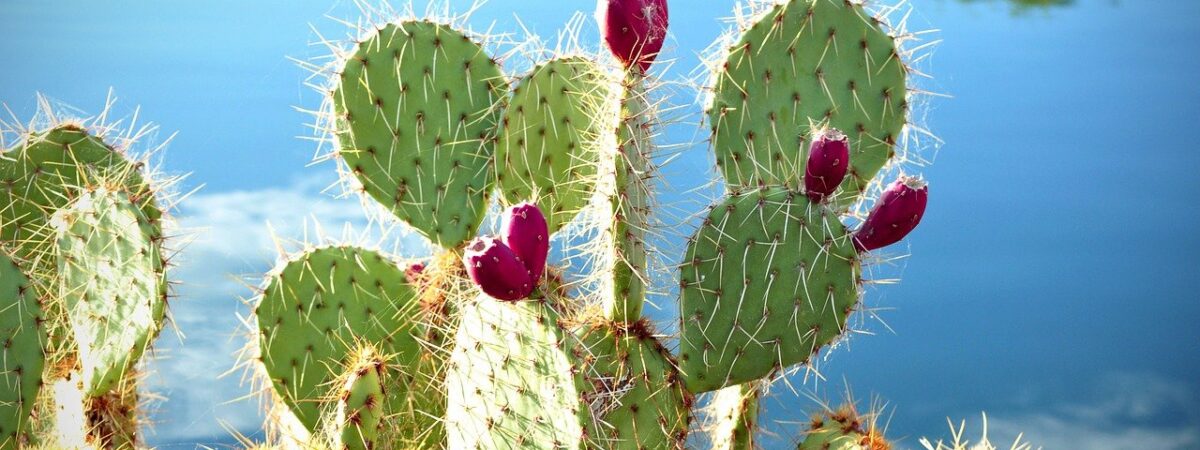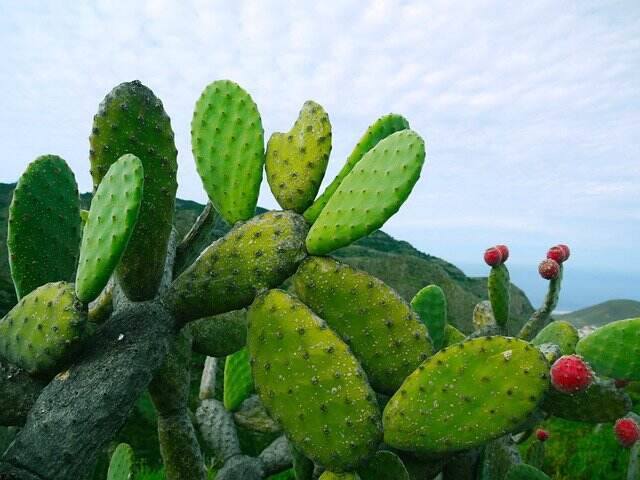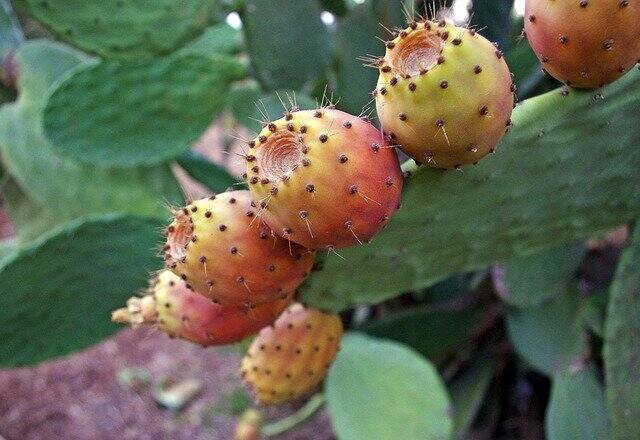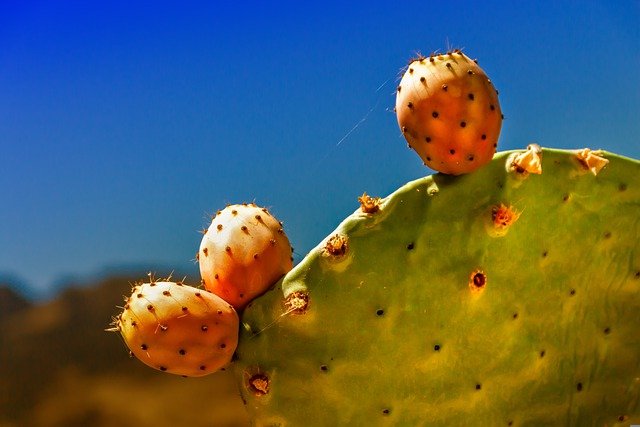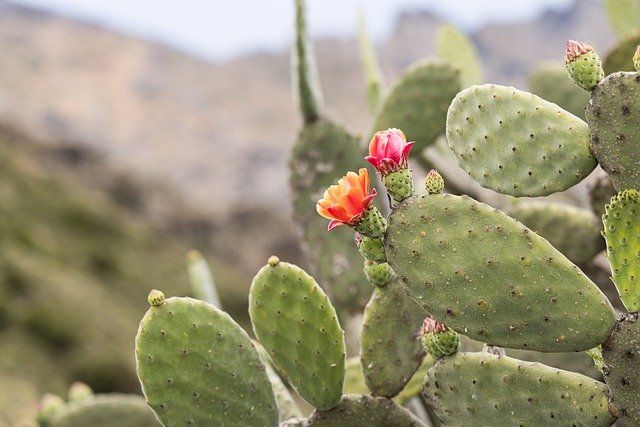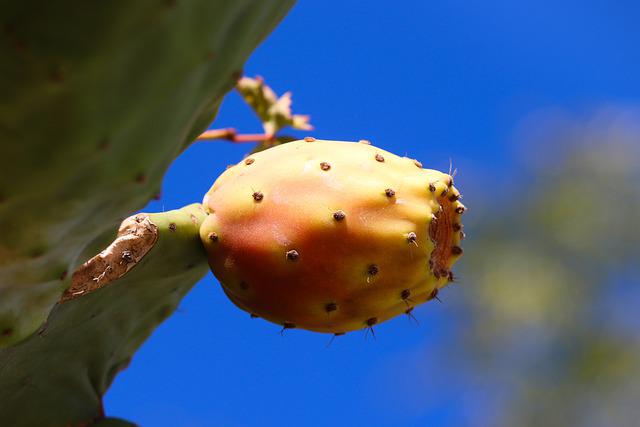Plant overview
Opuntia, popularly recognised as prickly pear or cactus pear, is a common genus of flowering plants in the cactus family (Cactaceae)
opuntia have green pads named cladodes that seems like large flattened paddles. These green pads features with a layer of spikes called areoles, which get sprouted large spines that help the plant to defend itself from predators.
Edible prickly pear cactus fruits or opuntia and the yellow or pink cactus flowers with different layers of sepals grow off from the ends of the plant’s pads.
The prickly pear cactus or opuntia is a flowering species of cacti which is native to the Americas. However, it has made its way across the world through various human activity.
These species sprouts purple-red fruit, which can be used to make jams, jellies, and some kinds of staples of Mexican cuisine (like nopales).
Varieties of Prickly pear
There are over 180 Opuntia species found in the world, many of them can grow in vastly different climates with different characteristics. Some of the most popular species of prickly pear cactus are given below.
Prickly pear cactus (Opuntia ficus-indica)
Ficus-indica, also named as Indian Fig Opuntia or Barbary Fig, is a popular variety of cactus which is spiny, segmented and grows large, flat cladodes. This plant blooms colourful flowers in shades of yellow, red, and white.
This cactus can attains the height of twenty feet tall and wideness of three feet. These species can thrive primarily in arid desert regions like southeastern North America, South Africa.
Bunny ear cactus (Opuntia microdasys)
Bunny ear cactus, also named as Polka Dot cactus or Angel’s Wings, is a popular variety of prickly pear which can be easily identifiable by its segmented pads that exactly resembles to the bunny ears, which are covered in bristly hairs named glochids.
Being native to dry areas of northern Mexico these bunny ear cactus can ranges upto the height of sixteen to twenty-four inches when it is mature.
Beavertail prickly pear (Opuntia basilaris)
Beavertail prickly pear or opuntia basilaris is a bushy succulent which only grows upto twelve inches tall but spreads out to the width of four feet.
This species of opuntia is disease-free and deer-resistant and it can adopted to a wide variety of soils and watering conditions.
Eastern prickly pear (Opuntia humifusa)
Eastern prickly pear cactus pr opuntia hemifusa is a popular variety of prickly pear which is native to eastern regions of the United States, like New England and Florida.
This variety showcases with pink and red flowers with seven or more petals. This variety of Opuntia is especially cold-hardy that usually needs little protection from freezing conditions due to anti-freezing elements in their cells.
Depending on the climate and locality they can grow anywhere and attains the height upto sixteen inches tall to over six feet high.
Panhandle prickly pear (Opuntia polyacantha)
Panhandle prickly pear ot popularly referred as the starvation prickly pear is a well known variant which can grow in many habitats, including northern Mexico, the Great Plains, and Western Canada.
These variant is very short and sprout flowers that bloom in magenta or yellow colors and attains the heights of twelve inches or less, with a spread of six to nine feet wide.
How to grow prickly pear cactus?
Prickly pear cactus are very easy to grow. However, they can take over three years to grow from seed.
So experts recommend to grow your prickly pear through cuttings to speed up the process. To grow your plant, you can obtain these cuttings at your local plant store or through specialty mail-away services.
The guide to grow prickly pear cactus from cuttings is given below.
Get cuttings
Get a cactus pad from a prickly pear cactus plant which is at least six months old. It is suggested to use a sharp knife or a pair of sterile shears to cut one of those pads from the cactus plant.
Lay your stem cuttings on a towel in a dry and shady area at least for a week until the cut end forms a callus.
Choose a perfect planting site
Then the next step is to choose a perfect planting site as it will help your plant to grow abundantly.
The planting spot of prickly pear should receive at least six hours of full sun a day, no matter if you’re keeping your cacti in an indoor container or planting them in your garden.
Prepare the soil
Like most of the cacti, prickly pears also eed loose, well-draining soil that have a neutral to slightly acidic soil pH. So prepare your soil accordingly.
Plant the cutting
Your cutting of prickly pear is ready to plant once it has formed a proper callus at the place where have made a cut.
Once it has made a callus, Place your cutting about one or two inches deep in the soil, and use some soil or some small rocks to hold the plant upright.
Avoid watering your cactus plant for the first one month after you plant it. The cactus pad contains enough moisture within itself to sustain for the first few months of growth.
How to care for prickly pear?
Light
As a desert cactus plant, prickly pear need to thrive in full sun. It shows that your plant need at least six hours of direct sunlight per day. If growing ndoors, a west- or south-facing window works best. In very hot climates, it may require some shade during midday can prevent scald.
Soil
The most important requirement for any plant in the Opuntia genus to grow is soil that drains well.
Prickly pear can grow easily in sandy or gravelly soil, but it can also tolerate other soil types as long as there are growing in a good drainage soil and not too much water.
Water
Prickly pear likes to grow in dry conditions, and it also requires very little watering to maintain the plant. That’s the main reason why cactus is often used in low-water gardens.
It is necessary to limit your watering to every two to three weeks or whenever the soil is completely dry. When watering, make sure just moisten the soil without soaking it. If you get minimun amount of rainfall, that’s often all the plant needs.
Temperature
Prickly pear cactus thrives to grow in hot, dry desert summers. But some of its species have good cold tolerance as well.
However, the opuntia does well in regions which have mild winters and hot summers with low humidity. Prickly pear can struggle in areas having very high humidity, even if the temperature is to the plant’s liking.
Fertilizer
Prickly pear doesn’t needs fertilizer regularly. However, it grows when planted in the ground, unless you have very poor soil.
If it is grown in containers, it uses up the soil’s nutrients faster and will require some feeding. If the green pads of the plant start to appear dull or if the plant doesn’t flower, that can mean it needs food.
In such case, you can apply a balanced fertilizer during the growing season, following product instructions. You also can apply a high-nitrogen fertilizer for larger pads or a low-nitrogen fertilizer for more flowers and fruits.
Common Pests & Plant Diseases
Prickly pear is very prone to a variety of insect pests, and disease that includes scale and mealybug. If they are from any disease, treat them with rubbing alcohol, neem oil, or a pesticide. Indoor plants are more susceptible to pests than outdoor plants.
All the species in the Opuntia or prickly pear genus can be prone to phyllosticta fungus, which may cause lesions in the pads, transitioning to large black spots that scab over.
Brought on by wet or humid weather, this fungus is not deadly. However, it is so contagious that it inevitably spreads to nearby plants. There is no effective treatment for this plant.
You just need to remove and dispose of infected pads to keep the fungus from spreading.
Conclusion
As you read this article this far, you might have known the growing and caring guide of the prickly pear or opuntia.
Then what are you waiting for?
Follow the above guideline, grow an opuntia or prickly pear in the ground, add some beauty to your garden with beautiful flowers and have the taste of opuntia fruit.
You may also like to read
Christmas Cactus – How to Propagate and Care for Christmas Cactus?
How to grow and care for Donkey’s tail succulent? – A detailed guide

